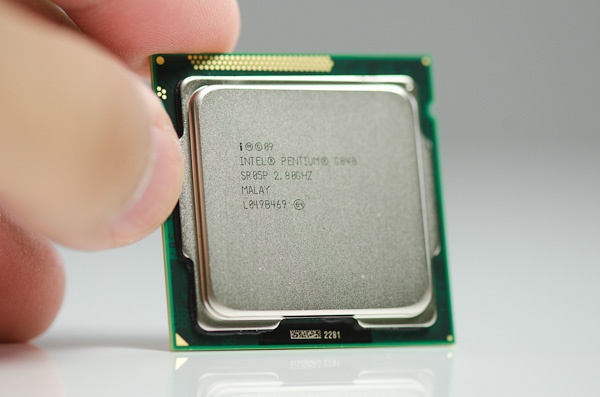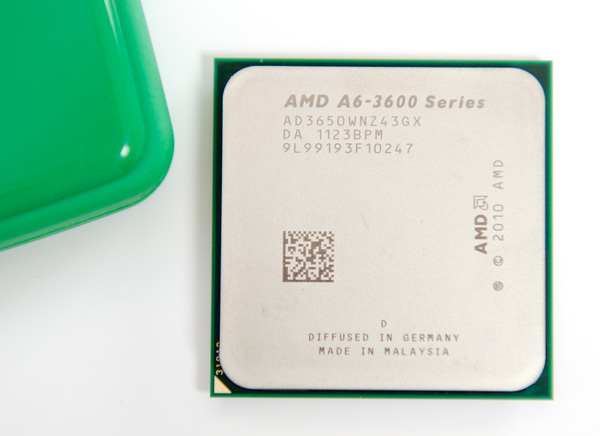The Sandy Bridge Pentium Review: G850, G840, G620 & G620T Tested
by Anand Lal Shimpi on August 23, 2011 12:11 AM ESTFinal Words
Despite boasting Intel's latest Sandy Bridge microarchitecture, the conclusions here are pretty much unchanged from the past. Intel maintains an advantage when it goes up against an AMD chip with the same number of cores, almost regardless of clock speed. In the case of the Pentium G620, even an Athlon II X2 265 with a 27% clock speed advantage can't outperform the Sandy Bridge based CPU. If you're choosing between chips with the same number of cores at the same price, Intel wins.
The decision tilts in AMD's favor if you start comparing to the Athlon II X3. In heavily threaded workloads, the Athlon II X3's third core helps put it ahead of the entire SNB Pentium lineup. If you're building a machine to do offline 3D rendering, multithreaded compiling or video transcoding then AMD continues to deliver the best performance per dollar. It's in the lighter, less threaded workloads that the Pentium pulls ahead. If you're building more of a general use system (email, web browsing, typical office applications and even discrete GPU gaming), the Pentium will likely deliver better performance thanks to its ILP advantages. What AMD has offered these past couple of years is an affordable way to get great multithreaded performance for those applications that need it.
Unfortunately the entire Sandy Bridge Pentium lineup is clock locked. Without turbo modes there's no support for overclocking at all. While these new Pentiums would have normally been great for enthusiasts looking to overclock, Intel has ensured that anyone looking to get more performance for free at the low end will have to shop AMD. Unfortunately Intel's advantage in single/lightly threaded performance is big enough that a clock speed advantage alone is generally not enough to make up for it (see G620 vs. Athlon II X2 265 comparison). It's sad that it has come to this. I was hoping we'd see more K-series SKUs at the low end but it seems like those will only be for the enthusiasts at the high end.
The Pentium's on-die GPU isn't particularly impressive. It's the HD Graphics 2000 from the rest of the Sandy Bridge lineup without Quick Sync or any of the extra video features. I am particularly sad that Quick Sync is missing as it would've made these Pentiums extremely attractive for users that do a lot of video transcoding. Thankfully video decode acceleration and HD audio bitstreaming support remain, so if you're looking to build a cheap Sandy Bridge based HTPC and don't care about the frills these chips will work just fine.
However, if you're building a system to do any sort of 3D gaming you're much better off either springing for a cheap discrete card or looking at AMD's A6-3650 if you want to stay integrated. Although you can play older titles at low resolution on the Pentium's on-board GPU, you'll have a much better experience with a discrete GPU or with the A6.
It all boils down to this. If you want a good, cheap, general purpose PC then the Pentium G620 seems competent and cheap. You can consider the G840 if you want a bit more performance. If you do a lot of threaded work (e.g. offline 3D rendering) the next step up is the Athlon II X3 455. If you do any amount of consumer level video transcoding using apps that are Quick Sync enabled, opt for the Core i3 2100 instead. If gaming is important to you then either buy a discrete GPU or look to AMD's Llano.
As far as AMD's A6 vs. A8 goes, the A8-3850 only commands a $20 price premium over the A6-3650. That $20 gives you another 8 - 10% on the CPU side and around 20% on the GPU. In my opinion, if you're considering a Llano system - spring for the A8.












110 Comments
View All Comments
loeakaodas - Tuesday, August 23, 2011 - link
Why intel, why? Do you still ram these chips down our throats, they're so short of features that would be great for a cheap HTPC, but aren't all that attractive if you want to do anything but basic stuff with your machine.Blaze-Senpai - Tuesday, August 23, 2011 - link
And this is aimed at those people that only want to do basic stuff with their machine.yankeeDDL - Tuesday, August 23, 2011 - link
It still makes no sense: a Pentium 850 costs $98 (http://www.newegg.com/Product/Product.aspx?Item=N8... an A6-3650 costs $119 (http://www.newegg.com/Product/Product.aspx?Item=N8...For $20 you get a real graphic cards which acelerated web browsing and video decoding, so it is actually very useful even for very basic systems.
I see no value, whatsoever, for entry-level Sandy Bridge, as they have a higher price/performance ratio than most AMD stuff.
Incidentally, while SB is undoubtedly the finest piece of CPU technology today, at these prices it makes sense only starting from the Core i5-2400, which, basically, outperforms nearly every AMD CPU.
ET - Tuesday, August 23, 2011 - link
A G620 plus a discrete low mid range ($70-80) GPU will give you a much better entry level gaming PC than an A6-3650, for not a lot more money. (For about the same price as an A8-3850, which will still be slower for gaming than the G620 system).yankeeDDL - Tuesday, August 23, 2011 - link
I am not convinced, but you might be right about the gaming rigs. I would argue that a cheap discrete graphic card would CrossFire nicely with tha A6, but that's not the point anyway.I was talking, however, about entry-level systems.
There`s a "Best CPU for the money" update on Tom's hardware today: you can see that the G620 is not even in the picture, in favor of the Athlon II X3 and the G850.
If I was to play games rarely, I would much rather have an efficient but relatively powerful APU, than having to use an external graphic card: this way I wouldn't have to pay the electricity bill to have my GPU run a screensaver.
Taft12 - Tuesday, August 23, 2011 - link
Perhaps, but an Athlon II X3 450 plus the same $70-80 GPU would make for an even better entry level gaming PC at the same price.lowlymarine - Tuesday, August 23, 2011 - link
Not really. Many games still struggle to hit even two cores efficiently; few if any would benefit significantly from the third.Roland00Address - Tuesday, August 23, 2011 - link
For example see Grand Theft Auto IV PC edition. This game is unplayable on a Dual Core pc without a massive overclock, but runs fine on a slow tri or quad core. This was due to Xbox 360 having a tri-core processor (The 360 cpu is also a PowerPC design not x86 but that doesn't really matter.)Samus - Tuesday, August 23, 2011 - link
great article Anand!owned66 - Sunday, February 10, 2013 - link
most games after 2011play very well with multicore systems
my qx6700 was maxed out at 100% playing bf3
playing with a 2600 sandy maxes out at 85% equally on all cores and gpu maxed at 100% gpu load
increasing gpu clocks would increase cpu load which is a good sign of fine tuning